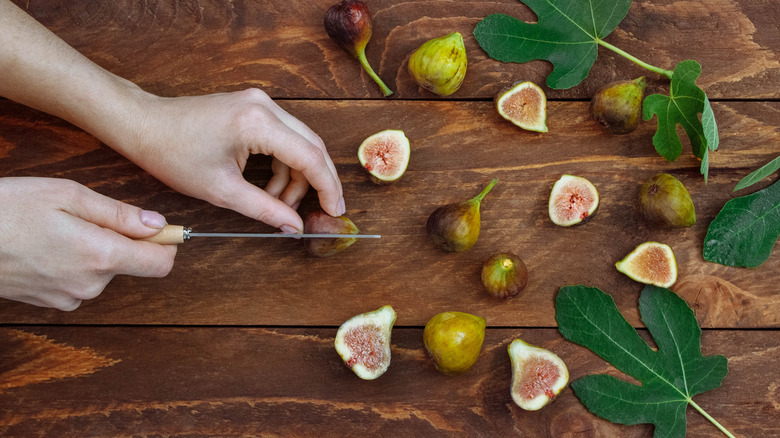You Never Knew This Fruit Has More Calcium Than A Glass Of Milk (But There's A Caveat)
Although reaching for a glass of cold milk might seem like the best way to give your body the calcium it deserves, you have other calcium-rich options that aren't lactose-laden. Many plant-based foods are surprisingly rich in calcium, including dried figs.
Dried figs clock in at a whopping 241 milligrams of calcium in a one-cup serving, according to the U.S. Department of Agriculture. Since the National Institutes of Health's calcium "fact sheet" recommends that most adults consume between 1,000 and 1,300 milligrams of calcium a day, you could conceivably get all the calcium you need from five cups of this fruit. However, you probably shouldn't. Although dried figs are nutrient-dense, they're also loaded with sugar.
While sugar in moderation can be part of a healthy diet, you don't want to go overboard. That's why it's essential to understand how to take advantage of the calcium benefits of dried figs without putting yourself at risk by indulging in too much daily sugar.
Calculating how much calcium to get from dried figs
The average adult should consume a relatively modest amount of sugar. According to Healthline, based on the American Heart Association's guidelines, women should limit their daily sugar consumption to 25 grams and men to 37.5 grams. However, the U.S. Department of Agriculture notes that a cup of dried figs serves up 71.4 grams of sugar. In other words, eating merely a half cup of dried figs would be more than the recommended sugar amount for a woman.
What's so concerning about eating sugar? For starters, it's been associated with numerous medical problems. One 2023 article published in Nutrients described sugar concerns rather succinctly: "...findings suggest a negative effect of excessive added sugar consumption on human health and wellbeing."
How much of a "negative effect" can sugar precipitate? MedicalNewsToday explains that overindulging in sugar can increase your risk of developing a host of physical and mental health issues, including depression, respiratory conditions, cardiovascular disease, some cancers, and gout. As if that weren't concerning enough, you're more likely to gain unwanted weight if you load up on sugar.
This doesn't mean you should ditch your dried fig habit if you want to keep your calcium levels high. It just means you have to get imaginative and selectively incorporate dried figs into your diet.
Conscientiously getting calcium from dried figs
You can increase your calcium with the assistance of dried figs without putting yourself at risk of a "sugar spike" or worrisome medical diagnosis. You simply have to be thoughtful about adding dried figs to your everyday diet.
For example, you could swap a couple of dried figs for a high-sugar dessert or snack. This allows you to satisfy your sweet tooth and boost your calcium while keeping your sugar consumption in check.
You could also supplement your calcium with other produce aisle foods. Many leafy green vegetables are full of calcium. As the aforementioned fact sheet from the National Institutes of Health indicates, a half-cup of boiled spinach provides 123 grams of calcium. Consequently, you don't have to rely solely on sugary dried figs to increase your calcium in a dairy-free way.
To stay on top of both your calcium and sugar intake, keep a record of what you're eating. Tracking your diet will reveal how well you're doing at getting enough calcium without getting too much sugar. It will give you a chance to more "mindfully" eat, too. In a 2019 article, the American Society for Nutrition cites a Journal of the Academy of Nutrition and Dietetics piece from 2016 that concludes: "Studies show that mindfulness has a great influence on how much we eat, how we feel when we eat and when we choose to eat." With a food journal, you can be certain you're making healthy dried fig choices.


